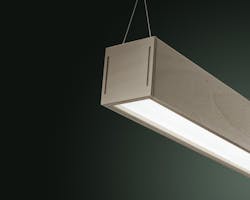The eco drum keeps beating anew in the lighting industry. In the latest sounding, Fagerhult Group is building a luminaire made from what it says is 77% “recycled or renewable materials,” including a wood housing — rather than metal or plastic — and plastic reflectors recovered from televisions.
CEO Bodil Sonesson drew attention to the new Kvisten office luminaire during the Swedish company’s recent upbeat first-quarter results call with analysts. Fagerhult operates 12 lighting companies. One of those, the eponymous Fagerhult, introduced Kvisten earlier this year in Sweden, but the corporate entity had not publicized it until two weeks ago, when Sonesson told analysts that it is “one of the most sustainable luminaires on the market.”
Whereas manufacturers tend to house luminaires with steel, glass, and plastic, Habo-based Fagerhult makes the new product from pine plywood, with a birch wood veneer. The word “kvisten” translates as “small wooden branch,” Sonesson said.
According to Fagerhult, the product adheres to strict sustainability principles as it is certified by the Forest Stewardship Council (FSC), a Bonn, Germany nonprofit group that monitors forest management to prevent deforestation and the destruction of ancient woodlands. FSC also protects biodiversity as well as fair work and community environments.
In another eco-minded feature, Kvisten makes use of reflective PET (polyethylene terephthalate) plastic recovered from television sets and converted into reflectors.
Fagerhult intends to build all its luminaires from at least 80% recycled or renewable material by 2030. Kvisten “is a big step in the right direction,” said Cecilia Niva, product and application manager for the Fagerhult product brand.
In similar environmental innovations in the lighting industry, Glamox recently introduced luminaires made from recycled aluminum, and Signify is offering its Coastal Breeze line manufactured with 3D printed material from recovered fishing nets. Signify has developed luminaires from other recycled materials. LEDs Magazine will report on these separately.
In a parallel movement, the industry is stepping up its efforts to retain existing installed luminaires by “remanufacturing” them. To that end, the U.K.’s Recolight will soon launch a matchmaking web portal aimed at buyers and sellers. In a similar vein, design schemes are increasingly including disassembly forethought to help in recovery of certain parts and materials.
MARK HALPER is a contributing editor for LEDs Magazine, and an energy, technology, and business journalist ([email protected]).
Follow our LinkedIn page for our latest news updates, contributed articles, and commentary, and our Facebook page for events announcements and more. You can also find us on Twitter.

Mark Halper | Contributing Editor, LEDs Magazine, and Business/Energy/Technology Journalist
Mark Halper is a freelance business, technology, and science journalist who covers everything from media moguls to subatomic particles. Halper has written from locations around the world for TIME Magazine, Fortune, Forbes, the New York Times, the Financial Times, the Guardian, CBS, Wired, and many others. A US citizen living in Britain, he cut his journalism teeth cutting and pasting copy for an English-language daily newspaper in Mexico City. Halper has a BA in history from Cornell University.





